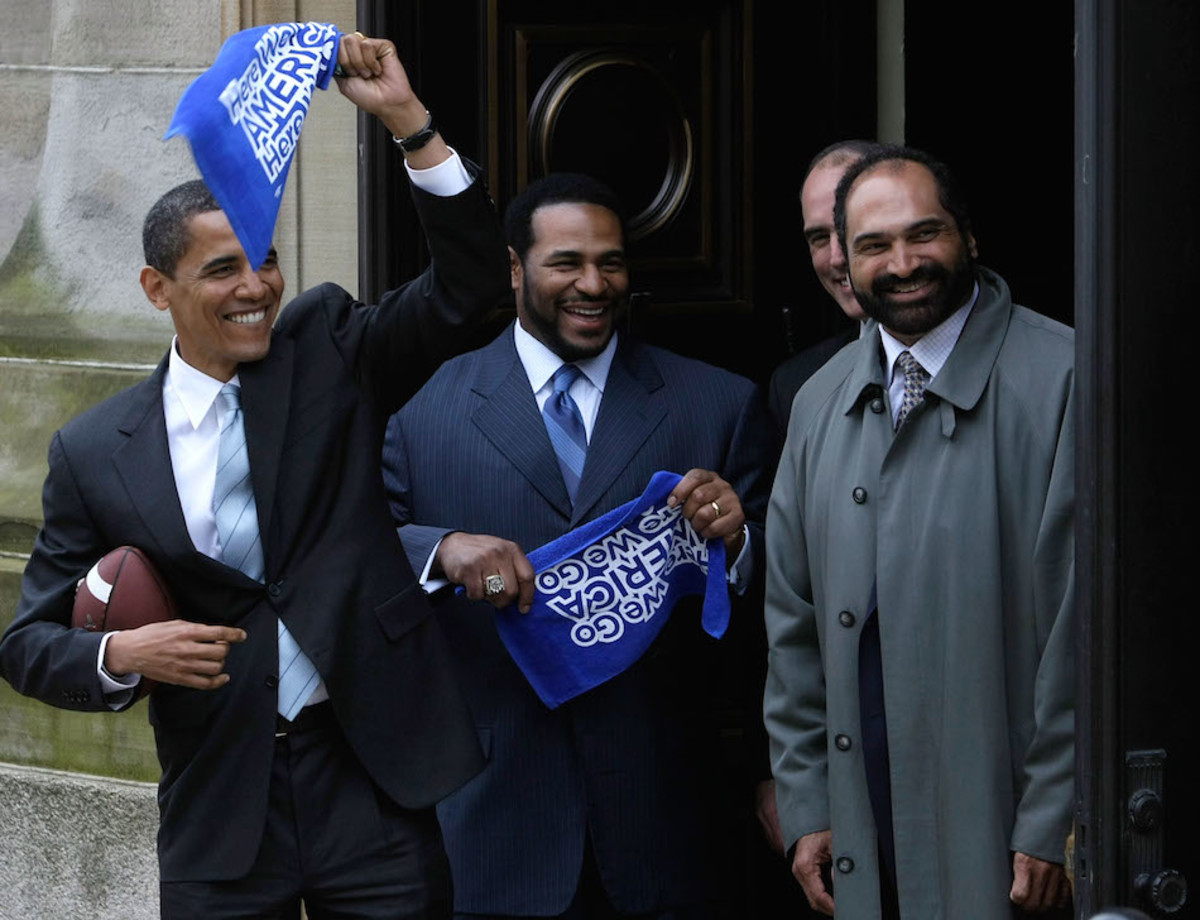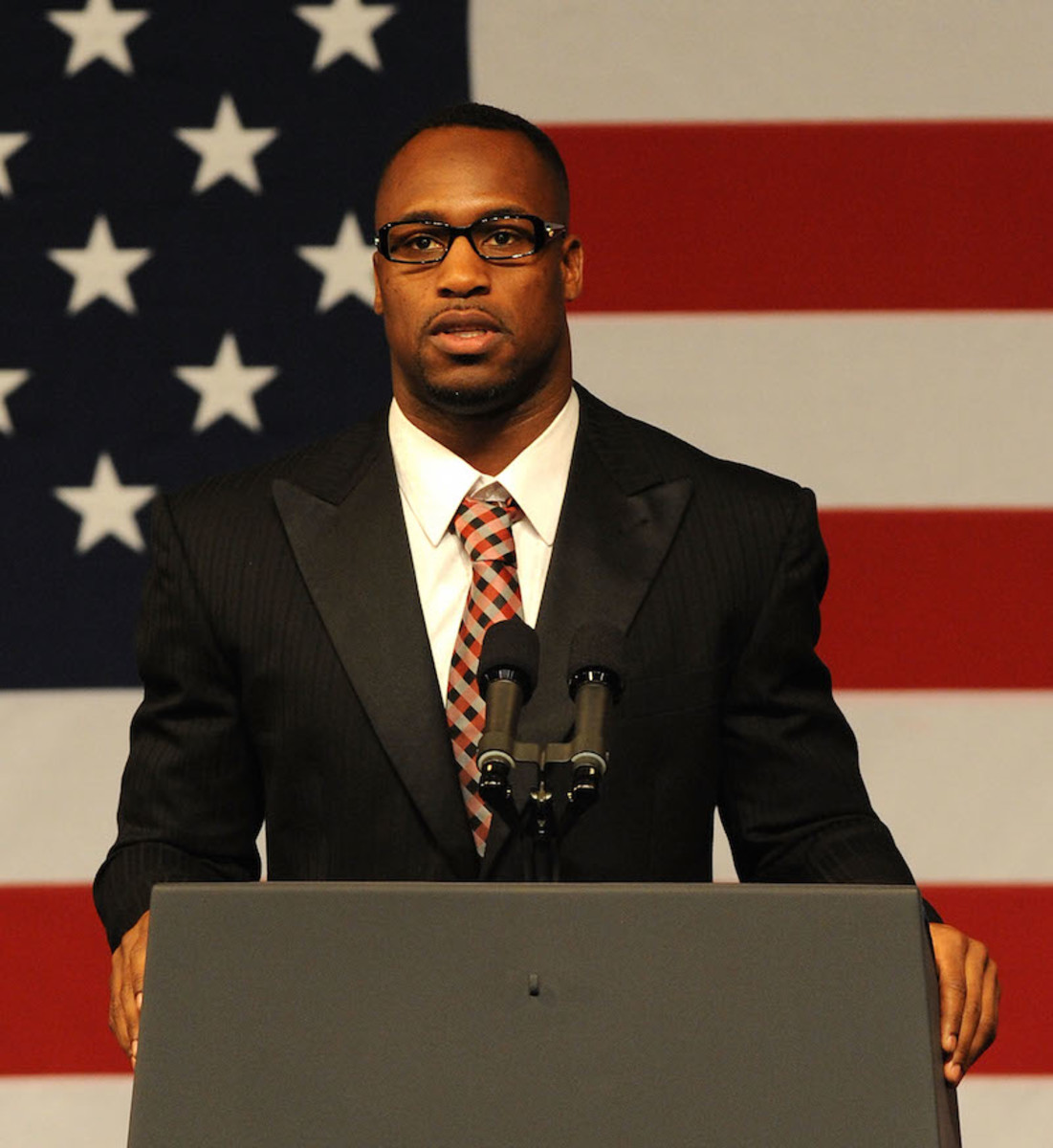NFL in action: How President Obama inspired a new wave of athlete activism

Baltimore Ravens tight end Benjamin Watson is hardly a fan of President Obama’s politics. A pro-life advocate, Watson voiced support for Ben Carson early in the 2016 campaign. Still, he describes Jan. 20, 2009, as “an amazing time.”
“I remember watching the inauguration with my wife,” he says. "I remember sitting there seeing this family that looked like how me and my wife and our family now look in the White House. Even to this day, it’s still this unbelievable thing.”
On the other side of the political spectrum, former NFL linebacker Brendon Ayanbadejo—a fierce promoter of marriage equality—had similar feelings on Inauguration Day. “From Chicago, multiracial with African descent, that’s exactly what I am,” he says. “I really felt like he represented me on so many levels.”
Across NFL locker rooms, the 2008 presidential election was special. After the results came in, Amani Toomer cried. Joey Porter welled up, too. Terrell Owens and Lovie Smith each celebrated the historic moment in comments to the press. “It doesn’t get any better than this, a historic day like we have today—the first black president,” Smith said after Obama made history.

The 2008 election did more than rouse intense emotion; it inspired action.
Donovan McNabb, then 31, voted for the first time. An ESPN study found that, by September, pro sports figures had combined to give twice as much money to candidates in ’08 as they had in either ’00 or ’04. A poll of then-49ers showed that the percentage of players willing to voice their support for one of the two candidates increased by 27 percent compared to four years earlier. "The apathy that had been there before this election cycle isn't here anymore,” Chargers kicker Nate Kaeding said at the time. "Guys who hadn't talked about it, hadn't even thought about it before, were engaged.” There was a great awakening of political interest across the league, not least because of the 47-year-old man at the center of the movement.
When Obama took the oath of office, Ayanbadejo says, “We all felt like we won a little bit.” He and his teammates saw the then-Senator empower their generation and, through signs of respect, embolden athletes in particular. Plus, players connected with Obama’s rise from humble beginnings. “We could identify with that,” Ayanbadejo says. “I think Obama really made us feel like he is just as American as us and we are just as American as him.”
Now what? That's the question for Doug Baldwin and other athlete activists
Obama’s involvement with the NFL and its players would continue as football and politics became entwined over eight years marked by debate.
It all started before he had even won the presidency. During a campaign interview that aired at halftime of a Steelers-Redskins Monday Night Football game, Obama said, "I think it is about time that we had playoffs in college football. You know, I am fed up with these computer rankings.” (For those keeping score, Mission Accomplished).
But the most consequential wave of political/football crossover would not come until 2014. It started in January, when Obama said in a New Yorker article that, if he had a son, he would not let him play football—and compared those who do play to boxers and smokers.
That spring, several players entered the debate swirling around Michael Sam, a seventh-round draft pick in ’14 who came out as gay earlier in the year. In December, Obama criticized the NFL for being “behind the curve” on its domestic violence protocol after the league’s much maligned handling of the Ray Rice case. That same month, five St. Louis Rams walked onto the field with their hands held up in reference to the shooting of Michael Brown in nearby Ferguson, Mo.
“2014 was hot,” Watson says. “That timespan was really hot…. These instances that were happening were very highly publicized. You couldn’t get away from them. They were everywhere.”
As Watson and other players see it, Obama’s presidency set the table for activism, but technological advances and societal tension fueled it.
When Watson entered the league during the 2004 election, MySpace was not yet a year old and Facebook was still only available to Harvard students. YouTube, Twitter, Reddit, and other online behemoths would emerge by ’08, giving athletes an easy way to use their stature—and showing them how interested people were in their thoughts. “I’m not that well known of an athlete,” Watson says, “But I wrote a Facebook post … and everybody wanted to read it and talk about the issues.”
Why we can expect increased athlete activism during Donald Trump's presidency
Those same social networks also kept players informed, whereas they might not have previously picked up a newspaper. “I think for a while, we kind of forgot all the things that were going on in our country,” Ayanbadejo says. “We weren’t really seeing them. You hear about them, but it’s different to read it versus you actually see it in HD quality on your iPhone on Facebook or Instagram.”
The storylines players encountered online often dealt with flashpoints regarding race, from the Henry Louis Gates arrest controversy in 2009, to the 2012 trial of George Zimmerman and the more recent Black Lives Matter movement. Those events pushed many players into action. In response to the national conversation, the University of Missouri team went on strike to protest racism on their campus. Colin Kaepernick sat during the national anthem and then opted to kneel, and players from around the league followed suit. A group text emerged to connect them as they organized community visits, held conversations with police officers, and made nonprofit donations. They got the President’s attention along the way.
Even when Obama said Kaepernick’s decision to kneel might be a “tough thing” for servicemen to handle, he encouraged the San Francisco QB’s protest. "Sometimes that's messy and controversial and it gets people angry and frustrated, but I'd rather have young people who are engaged in the argument and trying to think through how they can be part of our democratic process, than people who are just sitting on the sidelines and not paying attention at all,” he said.
Colin Kaepernick has already secured his legacy, even if he never starts another game
Redskins tight end Vernon Davis says he was one of the many players whose political interest ticked up in ‘08. “I just wanted to follow the blueprint that the President set in so many ways,” he says, and after getting to meet Obama—who welcomed Davis at a 2012 campaign stop—he was inspired again. In person, he got to see how big of a “sports fanatic” the President was, a guy who scrimmaged with UNC on the campaign trail and took time to fill out a men’s and women’s March Madness bracket each spring. That connection made the high office (and politics in general) more relatable, and Obama’s admiration of athletes—on display each time a champion team visited the White House—empowered many of them. “A lot of senators and congressmen are huge sports fans but you don’t see them that often,” Lions receiver Anquan Boldin says. “You realize they are just like we are… Every time I’ve been to Washington, I’ve been encouraged to not only come back myself but bring guys with me. They understand the power athletes have.”

It all adds up to what sports sociologist Harry Edwards has categorized as a new phase of athlete activism akin to what happened in the 1960s and 70s with Muhammad Ali, Jim Brown, and others. After an era marked by Charles Barkley shirking the responsibilities of a role model and Michael Jordan making sure Republicans bought his shoes, too, the 70-year-old Edwards now compares the current climate to when Jack Johnson dominated the boxing scene in the 1910s or when Jackie Robinson integrated baseball in the 50’s. And there’s more to come. “If Trump does anything close to what he proposed, you'll find athletes more directly and more militantly involved,” Edwards told SI in December.
Even if many players avoided the fray of the most recent election they searched for solutions and took action. Eagles safety Malcolm Jenkins participated in a ride-along with cops and traveled to Washington, D.C. to meet lawmakers with Boldin and other pros. Boldin said you can expect news of a second trip this off-season. Watson confronted race in a 2015 book, Under Our Skin, and has plans to speak about the issue this February alongside Tony Dungy, Warrick Dunn and others after participating in a forum with teammates during the season.
Plenty of what happened during Obama’s presidency left Watson disappointed and led to impassioned debates in locker rooms split much like America. But over time, a consensus developed too. NFL players realized the power they command—and found the motivation to use it.
